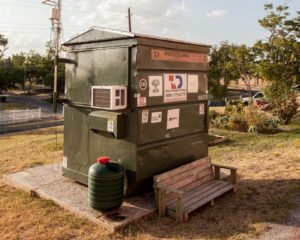LIVING SIMPLY IN A DUMPSTER

One professor left his home for a 36-square-foot open-air box, and he is happier for it. How much does a person really need?
Tucked behind the women’s residence halls in a back corner of Huston-Tillotson University’s campus in Austin, Texas, sits a green dumpster. Were it not for the sliding pitched roof and weather station perched on top, a reasonable person might dismiss the box as “just another dumpster”—providing this person did not encounter the dean of the University College Jeff Wilson living inside.
Professor Wilson went to the dumpster not just because he wished to live deliberately, and not just to teach his students about the environmental impacts of day-to-day life, and not just to gradually transform the dumpster into “the most thoughtfully-designed, tiniest home ever constructed.” Wilson’s reasons are a tapestry of these things.
Until this summer, the green dumpster was even less descript than it is now. There was no sliding roof; Wilson kept the rain out with a tarp. He slept on cardboard mats on the floor. It was essentially, as he called it, “dumpster camping.” The goal was to establish a baseline experience of the dumpster without any accoutrements, before adding them incrementally.
Not long ago, Wilson was nesting in a 2,500 square foot house. After going through a divorce (“nothing related to the dumpster,” he told me, unsolicited), he spun into the archetypal downsizing of a newly minted bachelor. He moved into a 500-square-foot apartment. Then he began selling clothes and furniture on Facebook for almost nothing. Now he says almost everything he owns is in his 36-square-foot dumpster, which is sanctioned and supported by the university as part of an ongoing sustainability-focused experiment called The Dumpster Project. “We could end up with a house under $10,000 that could be placed anywhere in the world,” Wilson said at the launch, “[fueled by] sunlight and surface water, and people could have a pretty good life.
Wilson, known around town as Professor Dumpster, recounted in another recent interview that he now owns four pairs of pants, four shirts, three pairs of shoes, three hats, and, in keeping with his hipsteresque aesthetic, “eight or nine” bow ties. (That’s an exceptional bow-tie-to-shirt ownership ratio.) He keeps all of this in cubbies under a recently installed false floor, along with some camping cooking equipment.
Customization of the space really began in July. Wilson asked Twitter what was the first thing he needed, and the response was almost unanimous: air conditioning. In the Austin heat, the dumpster was getting up to 130 degrees Fahrenheit during the day. On some nights it did not fall below the high 80s. So on his six-month anniversary of living in a human-sized convection oven, Wilson procured a modest air conditioner.
“We didn’t want to make it too easy,” Wilson said. “I wanted to see how elastic my sleeping habits would be relative to temperature and humidity. I found that I could actually get to sleep pretty well as long as I went to bed at about 11:00 p.m.”
With the weather station now strapped to the top, Wilson tracks his personal climate in real time. Pulling up data on his computer from inside his centrally cooled office as we spoke, he announced that the dumpster was currently 104 degrees. During the spring, when Austin was a little cooler, he was able to pass some daytime hours in the dumpster. With the arrival of summer, that became unbearable. “But some interesting things happened because of that,” he explained. He spent a lot more time out in the community, just walking around. “I almost feel like East Austin is my home and backyard,“ he said. He is constantly thinking about what sorts of things a person really needs in a house, and what can be more communal.
“What if everybody had to go to some sort of laundromat?” Wilson posited. “How would that shift how we have to, or get to, interact with others? I know I have met a much wider circle of people just from going to laundromats and wandering around outside of the dumpster when I would’ve been in there if I had a large flat screen and a La-Z Boy.”
Perks like insulation will come, allowing the small air conditioner to keep pace with the Texas sun. The second phase of The Dumpster Project, which Wilson and collaborators call the “average American dumpster studio,” will incorporate more amenities including a bed, a lamp, and a classic home-evoking pitched roof that will slide back and forth to allow ventilation, weather stripping, and locks (making this possibly the only dumpster in the world with interior locks). Eventually, the dumpster will have a dome to catch rainwater and provide shade, as well as a (tiny) sink and kitchen.
“Actually,” he said as we spoke by phone, “it is starting to rain right now, and my roof’s open on the dumpster.”
“Oh my god.”
“Can I call you right back? It’s a downpour. I’ll be back in about a minute.”
He called me back a minute later, sounding less distressed than one might expect from a person whose home had been drenched. The disposition that might make a person amenable to dumpster life is not one easily troubled by a little rain. His dumpster-home once looked like this:
He’s also welcoming of anyone who wants to stop by the dumpster and talk sustainability any time. In addition to teaching courses in environmental change, global health and welfare, and environmental science at the college, Wilson describes The Dumpster Project primarily as an educational initiative that just happened to dovetail with his current life-downsizing. On some nights, Wilson will stay with a friend, and students from the ecology-focused campus group Green Is the New Black will get a night to stay in the dumpster.
“What does home look like in a world of 10 billion people?” the project’s siteimplores, referring to the projected 40 percent increase in the human population by the end of the century. “How do we equip current and future generations with the tools they need for sustainable living practices?”
Unfortunately the site does not answer those questions in concrete terms. But with only 39 percent of Americans identifying as “believers” in global warming, just raising questions and promoting consciousness of sustainability might be a lofty enough aspiration.
Wilson’s most anticipated upcoming boon is a toilet. “I’m not as concerned about the shower,” he said, “but getting to the toilet sometimes requires kind of a midnight run.” Currently, he uses facilities at the university’s gym. A toilet and shower will soon connect to the dumpster externally. “You don’t really want to have a composting toilet inside of a closed-up 36 square feet,” he explained.
In four months Wilson will enter the third phase of the project, the “uber dumpster home.” That will involve installing solar panels and unplugging from the energy grid, as well as completing aesthetic work that will essentially remove any semblance of dumpsterdom. “We kind of want to do the outside in a modern Dwell look,” he said, including windows and reused lumber siding. “We want it basically to be such that if you were blindfolded and placed inside it, you’d just think you were in a very tiny house.”
Wilson already goes around to local elementary and middle schools recounting his experience in the context of talking about using less space, less energy, and less water, and creating less waste. There is a K–12 curriculum built around the dumpster experiment, and eventually the finished dumpster will be transported to these schools for display.
For Professor Dumpster, the undertaking is at once grand and diminutive, selfless and introspective, silly and gravely important, even dark. “We bring everything into the home these days,” Wilson said. “You don’t really need to leave the home for anything, even grocery shopping, anymore. What’s interesting about this is it’s really testing the limits of what you need in a home.”
“The big hypothesis we’re trying to test here is, can you have a pretty darn good life on much, much less?” He paused. “This is obviously an outlier experiment. But so far, I have, I’d say. A better life than I had before.”


